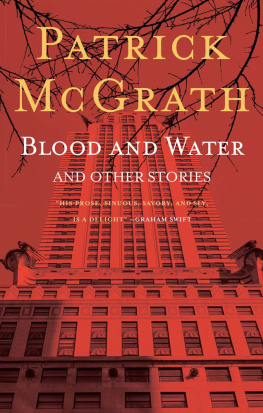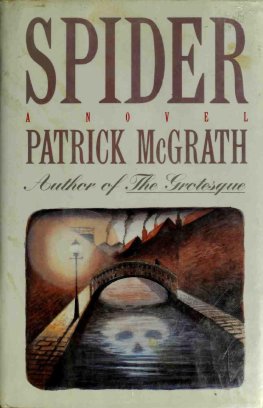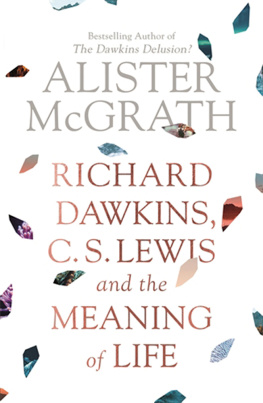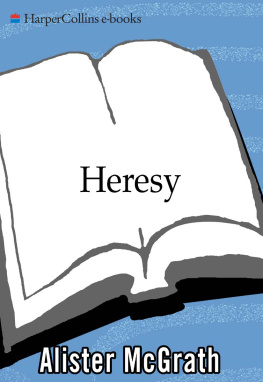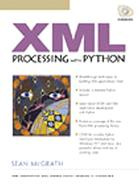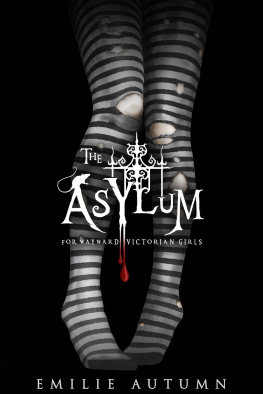Patrick McGrath - Asylum
Here you can read online Patrick McGrath - Asylum full text of the book (entire story) in english for free. Download pdf and epub, get meaning, cover and reviews about this ebook. year: 1998, publisher: Vintage Books, genre: Art. Description of the work, (preface) as well as reviews are available. Best literature library LitArk.com created for fans of good reading and offers a wide selection of genres:
Romance novel
Science fiction
Adventure
Detective
Science
History
Home and family
Prose
Art
Politics
Computer
Non-fiction
Religion
Business
Children
Humor
Choose a favorite category and find really read worthwhile books. Enjoy immersion in the world of imagination, feel the emotions of the characters or learn something new for yourself, make an fascinating discovery.

- Book:Asylum
- Author:
- Publisher:Vintage Books
- Genre:
- Year:1998
- Rating:3 / 5
- Favourites:Add to favourites
- Your mark:
- 60
- 1
- 2
- 3
- 4
- 5
Asylum: summary, description and annotation
We offer to read an annotation, description, summary or preface (depends on what the author of the book "Asylum" wrote himself). If you haven't found the necessary information about the book — write in the comments, we will try to find it.
Asylum — read online for free the complete book (whole text) full work
Below is the text of the book, divided by pages. System saving the place of the last page read, allows you to conveniently read the book "Asylum" online for free, without having to search again every time where you left off. Put a bookmark, and you can go to the page where you finished reading at any time.
Font size:
Interval:
Bookmark:
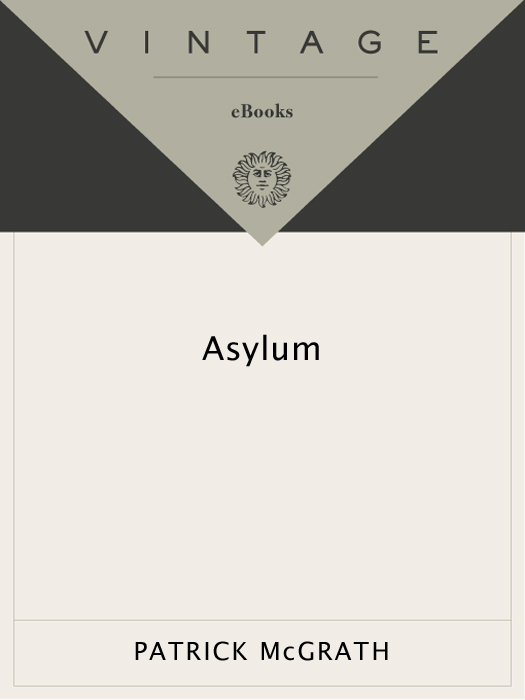
Acclaim for Patrick McGraths
ASYLUM
Superb. Asylum is McGraths most somber and most realistic book, and also his best.
The New Yorker
A book as absorbing as it is intelligent. The story of this love affair unfolds like a dream into a nightmarethe characters move relentlessly toward their tragic end with desire raging like a fire, gathering strength and destroying everything and everyone in its path.
Los Angeles Times
We dont associate Gothic novels with elegance and discretion, but these are the defining features of Patrick McGraths work.
The New York Times Book Review
A tour de force. From beginning to end Asylum is a hypnotic read, beautifully judged and ruthlessly manipulative.
San Francisco Chronicle
A cleverly insidious, beautifully rendered thriller with just the right balance of splatter and innuendo.
Entertainment Weekly
Brilliant a beautiful, relentless novel. McGrath renders Stellas passion for Edgar so vivid and so comprehensible that as readers we cannot imagine her life without him any more than she can. We can only wring our hands and keep turning the glittering pages.
New York Newsday
McGrath, always a worthy descendant of Poe, here takes things a level higherproducing fiction in the tradition of Henry James A truly complex (but never obscure) novel.
Kirkus Reviews (starred review)
Skillfully executed intelligent Asylum is undoubtedly a solid read.
New York Daily News
Outrageously fun smart, frightening, funny and surprisingly affecting, McGraths latest elevates the psychiatric casestudy to high art.
Salon
McGraths talent as a writer is first class.
Bomb
Coolly compelling. The books power ultimately lies not only in the story it tells, but how its told and who is doing the telling.
Chicago Tribune
A virtuoso of contrast, McGrath wields a cleverly modernized form of Victorianism, precise and stately, to render scenes of unsettling and suspenseful eroticism.
Booklist
McGraths chillingly scientific prose lend an eeriness to Asylum that elevates it from a good thriller to a flawless expression of the arabesque.
Book Page
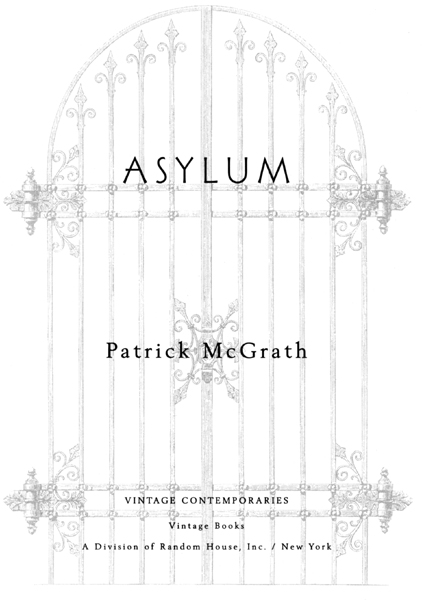
Contents
For Jack Davenport
ACKNOWLEDGMENTS
For all her help and support in the writing of this, my love and gratitude to my wife, Maria; and for his assistance with matters of psychiatry my warmest thanks to Dr. Brian OConnell.
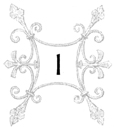
The catastrophic love affair characterized by sexual obsession has been a professional interest of mine for many years now. Such relationships vary widely in duration and intensity but tend to pass through the same stages. Recognition. Identification. Assignation. Structure. Complication. And so on. Stella Raphaels story is one of the saddest I know. A deeply frustrated woman, she suffered the predictable consequences of a long denial collapsing in the face of sudden overwhelming temptation. And she was a romantic. She translated her experience with Edgar Stark into the stuff of melodrama, she made of it a tale of outcast lovers braving the worlds contempt for the sake of a great passion. Four lives were destroyed in the process, but whatever remorse she may have felt she clung to her illusions to the end. I tried to help but she deflected me from the truth until it was too late. She had to. She couldnt afford to let me see it clearly, it would have been the ruin of the few flimsy psychic structures she had left.
Stella was married to a forensic psychiatrist called Max Raphael and they had a son, Charlie, aged ten when all this happened. She was the daughter of a diplomat whod been disgraced in a scandal years before. Both her parents were dead now. She was barely out of her teens when she married Max. He was a reserved, rather melancholy man, a competent administrator but weak; and he lacked imagination. It was obvious to me the first time I met them that he wasnt the type to satisfy a woman like Stella. They were living in London when he applied for the position of deputy superintendent. He came down for an interview, impressed the board and, more important, impressed the superintendent, Jack Straffen. Against my advice Jack offered him the job, and a few weeks later the Raphaels arrived at the hospital. It was the summer of 1959 and the Mental Health Act had just been passed into law.
This is a desolate sort of a place, though God knows its had the best years of my life. It is maximum-security, a walled city that rises from a high ridge to dominate the surrounding country: dense pine forest to the north and west, low-lying marshland to the south. It is built on the standard Victorian linear model, with wings radiating off the main blocks so that all the wards have an unobstructed view across the terraces to the open country beyond the Wall. This is a moral architecture, it embodies regularity, discipline, and organization. All doors open outward to make them impossible to barricade. All windows are barred. Only the terraces, descending by flights of stone steps to the perimeter wall at the foot of the hill, and planted with trees, grassy banks, and flower gardens, soften and civilize the grim carceral architecture standing over them.
The deputy superintendents house is just a hundred yards from the Main Gate. It is a large dark house of the same gray stone as the hospital, set back from the estate road and hidden by pine trees. It was much too big for the Raphaels, having been built at a time when doctors came with large families and at least two servants. For several years before their arrival it had stood empty, and the garden was neglected and wild. To my surprise Max took an immediate interest in its rehabilitation. He had the goldfish pond at the back of the house cleaned out and restocked, and the rhododendron bushes around the edge of the lawn cut back and made to flower.
The project that most interested him however was the restoration of an old conservatory at the far end of the vegetable garden. This was a large ornate glasshouse built in the last century for the cultivation of orchids and lilies and other delicate tropical plants. In its time it had been an imposing, airy structure, but when Max and Stella arrived it was in a state of such disrepair there was talk of pulling it down. Much of the glass was broken and what panes remained were thick with dust and cobwebs. The paintwork had flaked off and the woodwork in places was rotted and splitting. Birds had nested inside it, mice and spiders had made their home there, weeds had sprouted through the cracks in the stone floor.
But Max Raphael had an affection for all things Victorian, and the exotic architecture of this garden conservatory, with its intricate glazing and joinery, and the graceful Romanesque arches of its windows, all this gave him peculiar delight. He was fortunate that among the hospitals parole patients was a man confident that he could do the work of restoring the conservatory. This was the sculptor Edgar Stark.
Edgar was one of mine. I have always been fascinated by the artistic personality, I think because the creative impulse is so vital a quality in psychiatry; certainly it is in my own clinical work. Edgar Stark was already influential in the art world when he came to us, though what we first saw was a confused and very shaky man who shuffled into the hospital like a wounded bear and sat hunched on a bench for hours with his head in his hands. He intrigued me from the start, and once Id settled him down and got him talking I discovered him to be a forceful individual with an original mind, and I also realized that he was possessed of considerable charm, when he chose to use it. He and I quickly came to enjoy a warmly combative relationship, which I encouraged, up to a point; I wanted him to feel he had a special relationship with his doctor.
Font size:
Interval:
Bookmark:
Similar books «Asylum»
Look at similar books to Asylum. We have selected literature similar in name and meaning in the hope of providing readers with more options to find new, interesting, not yet read works.
Discussion, reviews of the book Asylum and just readers' own opinions. Leave your comments, write what you think about the work, its meaning or the main characters. Specify what exactly you liked and what you didn't like, and why you think so.


